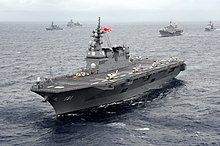
An aircraft carrier is a warship that serves as a seagoing airbase, equipped with a full-length flight deck and facilities for carrying, arming, deploying, and recovering aircraft. Typically, it is the capital ship of a fleet, as it allows a naval force to project air power worldwide without depending on local bases for staging aircraft operations. Carriers have evolved since their inception in the early twentieth century from wooden vessels used to deploy balloons to nuclear-powered warships that carry numerous fighters, strike aircraft, helicopters, and other types of aircraft. While heavier aircraft such as fixed-wing gunships and bombers have been launched from aircraft carriers, these aircraft have not landed on a carrier. By its diplomatic and tactical power, its mobility, its autonomy and the variety of its means, the aircraft carrier is often the centerpiece of modern combat fleets. Tactically or even strategically, it replaced the battleship in the role of flagship of a fleet. One of its great advantages is that, by sailing in international waters, it does not interfere with any territorial sovereignty and thus obviates the need for overflight authorizations from third-party countries, reduces the times and transit distances of aircraft and therefore significantly increases the time of availability on the combat zone.

A carrier battle group (CVBG) is a naval fleet consisting of an aircraft carrier capital ship and its large number of escorts, together defining the group. The CV in CVBG is the United States Navy hull classification code for an aircraft carrier.

Príncipe de Asturias, originally named Almirante Carrero Blanco, was a light aircraft carrier and former flagship of the Spanish Navy. She was built in Bazán's Shipyards and delivered to the Spanish Navy on 30 May 1988.
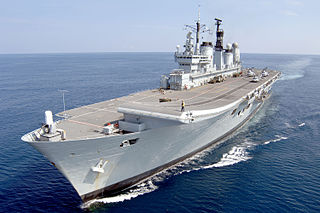
The Invincible class was a class of light aircraft carrier operated by the Royal Navy. Three ships were constructed: HMS Invincible, HMS Illustrious and HMS Ark Royal. The vessels were built as aviation-capable anti-submarine warfare (ASW) platforms to counter the Cold War North Atlantic Soviet submarine threat, and initially embarked Sea Harrier aircraft and Sea King HAS.1 anti-submarine helicopters. With cancellation of the aircraft carriers renewal programme in the 1960s, the three ships became the replacements for Ark Royal and Eagle fleet carriers and the Centaur-class light fleet carriers, and the Royal Navy's sole class of aircraft carrier.

NAeL Minas Gerais was a Colossus-class light aircraft carrier operated by the Marinha do Brasil from 1960 until 2001. The ship was laid down for the United Kingdom's Royal Navy during World War II as HMS Vengeance, was completed shortly before the war's end, and did not see combat. After stints as a training vessel and Arctic research ship, the carrier was loaned to the Royal Australian Navy from 1952 to 1955. She was returned to the British, who sold her to Brazil in 1956.

A light aircraft carrier, or light fleet carrier, is an aircraft carrier smaller than the standard carriers of a navy. The precise definition of the type varies by country; light carriers typically have a complement of aircraft only one-half to two-thirds the size of a full-sized fleet carrier. A light carrier was similar in concept to an escort carrier in most respects; however, light carriers were intended for higher speeds to be deployed alongside fleet carriers, while escort carriers were typically relatively slow and usually defended equally slow convoys, as well as providing air support during amphibious operations.

The Centaur class aircraft carrier was the final iteration of the 1942 Design Light Fleet Carrier developed by the United Kingdom for the Royal Navy during the Second World War. They were designed in 1943 to operate higher-performance aircraft than the preceding Majestic-class aircraft carrier. Four ships were laid down in 1944-1945 and completed in 1953-1959. Rapid developments in carrier warfare and technology overtook the ships even as they were under construction, and the associated costs of modernization led to ships being completed to different specifications. Only the last ship, HMS Hermes (R12), was fitted as a modern fixed-wing carrier; she was also the last of the class to retire in 2017 as INS Viraat.

The 1942 Design Light Fleet Carrier, commonly referred to as the British Light Fleet Carrier, was a light aircraft carrier design created by the Royal Navy during the Second World War, and used by eight naval forces between 1944 and 2001. They were designed and constructed by civilian shipyards to serve as an intermediate step between the expensive, full-size fleet aircraft carriers and the less expensive but limited-capability escort carriers.

ARA Veinticinco de Mayo (V-2) was an aircraft carrier in the Argentine Navy from 1969 to 1997. The English translation of the name is Twenty-fifth of May, which is the date of Argentina's May Revolution in 1810.
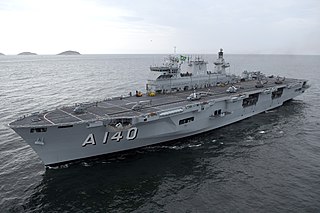
Landing platform helicopter (LPH) is a term used by some navies to denote a type of amphibious warfare ship designed primarily to operate as a launch and recovery platform for helicopters and other VTOL aircraft. As such, they are considered a type of helicopter carrier.

Naval aviation is the application of military air power by navies, whether from warships that embark aircraft, or land bases.
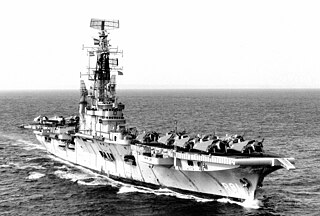
HNLMS Karel Doorman (R81) was a Colossus-class aircraft carrier of the Royal Netherlands Navy. Formerly the British ship HMS Venerable, she was sold to the Netherlands in 1948 as a light attack carrier. In 1960, she was involved in the decolonization conflict in Western New Guinea with Indonesia. In the mid 1960s, her role was changed to anti-submarine warfare carrier and only ASW aircraft and helicopters were carried. An engine room fire took her out of service in 1968. She was sold to Argentina in 1969 and renamed ARA Veinticinco de Mayo.

Command of the sea is a naval military concept regarding the strength of a particular navy to a specific naval area it controls. A navy has command of the sea when it is so strong that its rivals cannot attack it directly. This dominance may apply to its surrounding waters or may extend far into the oceans, meaning the country has a blue-water navy. It is the naval equivalent of air supremacy.
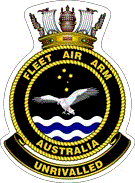
The Fleet Air Arm (FAA), known formerly as the Australian Navy Aviation Group, is the division of the Royal Australian Navy (RAN) responsible for the operation of aircraft. The FAA was founded in 1947 following the purchase of two aircraft carriers from the Royal Navy. FAA personnel fought in the Korean War and the Vietnam War, and participated in later conflicts and operations from host warships.

A helicopter carrier is a type of aircraft carrier whose primary purpose is to operate helicopters. It has a large flight deck that occupies a substantial part of the deck, which can extend the full length of the ship like HMS Ocean of the Royal Navy (RN), or extend only partway, usually aft, as in the Soviet Navy's Moskva class or in the Chinese Navy's Type 0891A. It often also has a hangar deck for the storage and maintenance of rotorwing aircraft.

An amphibious assault ship is a type of warship employed to land and support ground forces on enemy territory during an armed conflict. The design evolved from aircraft carriers converted for use as helicopter carriers. Modern designs support amphibious landing craft, with most designs including a well deck. Like the aircraft carriers they were developed from, some amphibious assault ships also support V/STOL fixed-wing aircraft and have a secondary role as aircraft carriers.

Aircraft carriers have their origins during the days of World War I. The earliest experiments consisted of fitting temporary "flying off" platforms to the gun turrets of the warships of several nations, notably the United States and the United Kingdom. The first ship to be modified with a permanent flight deck was the battlecruiser HMS Furious, which initially had a single flying-off deck forward of the original superstructure. Subsequently, she was modified with a separate "landing on" deck aft and later with a full flush deck. Other ships, often liners, were modified to have full flush flight decks, HMS Argus being the first to have such modification begun. Those first faltering steps gave little indication of just how important the aircraft carrier was to prove to be. During the inter-war years, Japan, the United Kingdom and the United States built up significant carrier fleets so that by the beginning of World War II, they had 18 carriers between them. The 1940 Battle of Taranto and 1941 Attack on Pearl Harbor in retrospect showed the world that the aircraft carrier was to be the most important ship in the modern fleet. Today, aircraft carriers are the capital ships of the navies they serve in, and in the case of modern US "supercarriers", they embark an air group that is effectively a small air force.
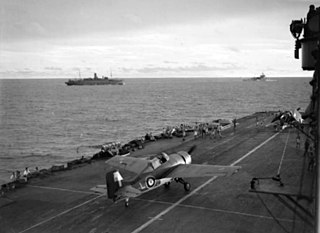
Aircraft carriers are warships that evolved from balloon-carrying wooden vessels into nuclear-powered vessels carrying many dozens of fixed- and rotary-wing aircraft. Since their introduction they have allowed naval forces to project air power great distances without having to depend on local bases for staging aircraft operations.

A carrier-based aircraft is a naval aircraft designed for operations from aircraft carriers. Carrier-based aircraft must be able to launch in a short distance and be sturdy enough to withstand the abrupt forces of launching from and recovering on a pitching deck. In addition, their wings are generally able to fold up, easing operations in tight quarters.



